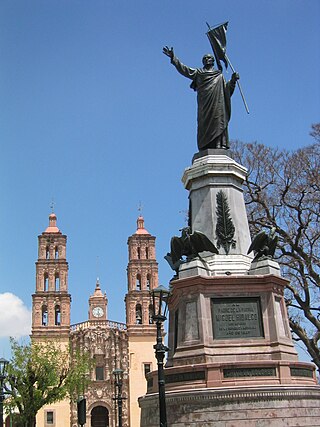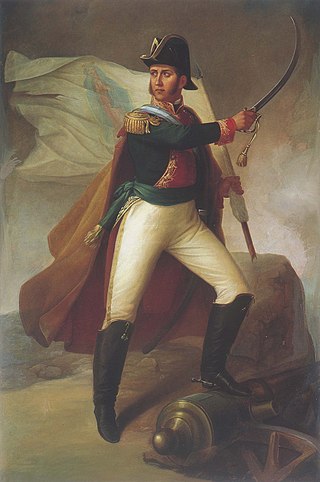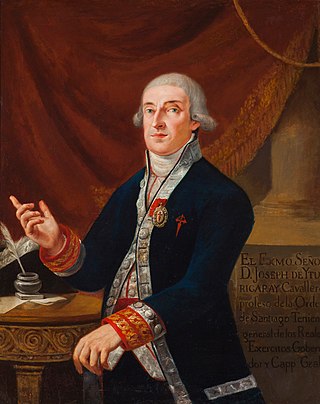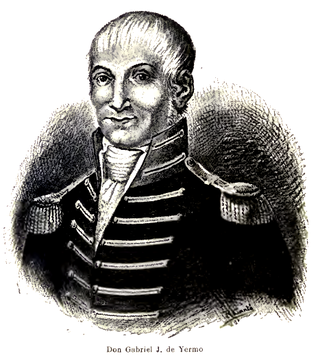
Don Miguel Gregorio Antonio Ignacio Hidalgo y Costilla Gallaga Mandarte y Villaseñor, commonly known as Miguel Hidalgo y Costilla or Miguel Hidalgo, was a Catholic priest, leader of the Mexican War of Independence and recognized as the Father of the Nation.

The Cry of Dolores occurred in Dolores, Mexico, on 16 September 1810, when Roman Catholic priest Miguel Hidalgo y Costilla rang his church bell and gave the call to arms that triggered the Mexican War of Independence. The Cry of Dolores is most commonly known by the locals as "El Grito de Independencia".

The Mexican War of Independence was an armed conflict and political process resulting in Mexico's independence from the Spanish Empire. It was not a single, coherent event, but local and regional struggles that occurred within the same period, and can be considered a revolutionary civil war. It culminated with the drafting of the Declaration of Independence of the Mexican Empire in Mexico City on September 28, 1821, following the collapse of royal government and the military triumph of forces for independence.

María Josefa Crescencia Ortiz Téllez–Girón, popularly known as Doña Josefa Ortiz de Domínguez or La Corregidora was an insurgent and supporter of the Mexican War of Independence, which fought for independence against Spain, in the early 19th century. She was married to Miguel Domínguez, corregidor of the city of Querétaro, hence her nickname.

Ignacio José de Allende y Unzaga, commonly known as Ignacio Allende, was a captain of the Spanish Army in New Spain who came to sympathize with the Mexican independence movement. He attended the secret meetings organized by Josefa Ortiz de Domínguez, where the possibility of an independent Mexico was discussed. He fought along with Miguel Hidalgo y Costilla in the first stage of the struggle, eventually succeeding him in leadership of the rebellion. Allende was captured by Spanish colonial authorities while he was in Coahuila and executed for treason in Chihuahua.

Gastón Carrillo de Peralta y Bosquete, 3rd Marquess of Falces (1510–1587) was a Spanish nobleman who was the third viceroy of the Viceroyalty of New Spain from October 16, 1566 to March 10, 1568.

In Hispanic America, criollo is a term used originally to describe people of full Spanish descent born in the viceroyalties. In different Latin American countries, the word has come to have different meanings, mostly referring to the local-born majority. Historically, they have been misportrayed as a social class in the hierarchy of the overseas colonies established by Spain beginning in the 16th century, especially in Hispanic America. They were locally-born people–almost always of Spanish ancestry, but also sometimes of other European ethnic backgrounds.

José Joaquín Vicente de Iturrigaray y Aróstegui, KOS was a Spanish military officer and viceroy of New Spain, from 4 January 1803 to 16 September 1808, during Napoleon's invasion of Spain and the establishment of a Bonapartist regime in Spain. His plans to form a provisional autonomous government led to his arrest and deposition.

Carlos Francisco de Croix, 1st Marquess of Croix, was a Spanish general and viceroy of New Spain, from August 25, 1766, to September 22, 1771, a period of considerable turbulence.

Manuel Antonio Flórez Maldonado Martínez Ángulo y Bodquín was a general in the Spanish navy and viceroy of New Granada and New Spain.

Miguel José de Azanza y Alegría, 1st Duke of Santa Fe, KOS was a Spanish politician and diplomat, and viceroy of New Spain from May 31, 1798 to April 30, 1800.
Pedro de la Portilla was an 18th-century Criollo rebel in New Spain against the Spanish. He was the leader of the Conspiracy of the Machetes, an unsuccessful rebellion in 1799. Although the conspiracy posed no threat to Spanish rule, nevertheless it was a shock to the rulers. Coming only 11 years before the Grito de Dolores, it is considered in modern Mexico to be a forerunner of the Mexican War of Independence.

Pedro de Garibay was a Spanish military officer and, from September 16, 1808 to July 19, 1809, viceroy of New Spain.

Gabriel J. de Yermo was a wealthy landowner in New Spain, leader of the anti-independence party, and leader of the coup that overthrew Viceroy José de Iturrigaray in 1808.

Francisco Javier de Lizana y Beaumont was bishop of Mexico and, from 19 July 1809 to 8 May 1810, viceroy of New Spain.

Félix María Calleja del Rey y de la Gándara, primer conde de Calderón was a Spanish military officer and viceroy of New Spain from March 4, 1813, to September 20, 1816, during Mexico's War of Independence. For his service in New Spain, Calleja was awarded with the title Count of Calderon.

José Miguel Domínguez Alemán was a New Spanish colonial official in New Spain who played a part in the Mexican independence movement. He was also a member of a transitional governing committee in the period between the abdication of Mexican Emperor Agustín de Iturbide and the installation of Guadalupe Victoria as the first president of independent Mexico. His wife, Josefa Ortiz de Domínguez, also known as La Corregidora, was a heroine of Mexican independence.

Francisco Primo de Verdad y Ramos was a Novohispanic lawyer and politician and a proponent of Mexican independence from Spain. He was imprisoned by the Spanish authorities for his advocacy, and died in prison. He is considered one of the protomartyrs of Mexican independence.

The following is a partial timeline (1810–1812) of the Mexican War of Independence (1810–1821), its antecedents and its aftermath. The war pitted the royalists, supporting the continued adherence of Mexico to Spain, versus the insurgents advocating Mexican independence from Spain. After of struggle of more than 10 years the insurgents prevailed.

The Capture of Alhóndiga de Granaditas was a military action carried out in Guanajuato, viceroyalty of New Spain, on September 28, 1810, between the royalist soldiers of the province and the insurgents commanded by Miguel Hidalgo and Ignacio Allende. The fear unleashed in the social circles of the provincial capital made the intendant, Juan Antonio Riaño, ask the population to barrack in the Alhóndiga de Granaditas, a granary built in 1800, and in whose construction Miguel Hidalgo had participated as an advisor to his old friend Riaño. After several hours of combat, Riaño was killed and the Spaniards who had taken refuge there wished to surrender. The military in the viceroy's service continued the fight, until the insurgents managed to enter and then massacred not only the few guards that defended it, but also the numerous families of civilians who had taken refuge there. Many historians consider this confrontation more like a mutiny or massacre of civilians than a battle, since there were no conditions of military equality between the two sides.


















